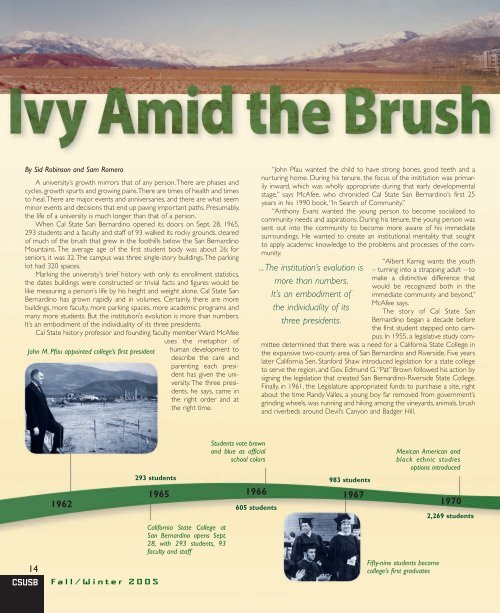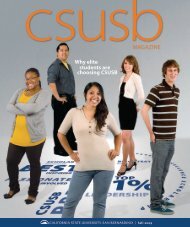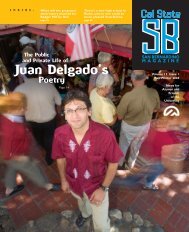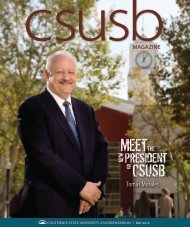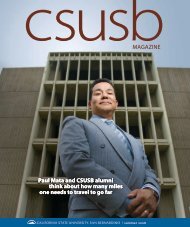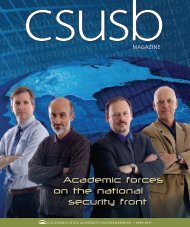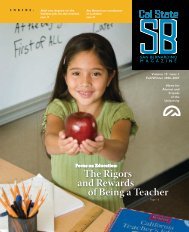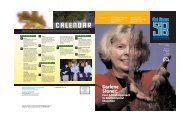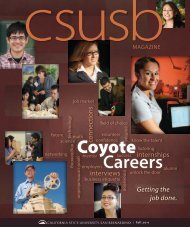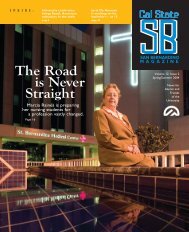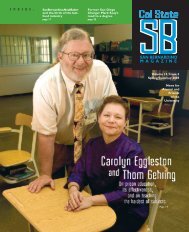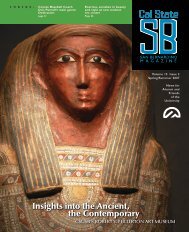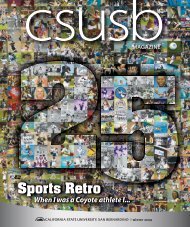Volume 14 Issue 1 Fall/Winter 2005-06 News for Alumni and Friends ...
Volume 14 Issue 1 Fall/Winter 2005-06 News for Alumni and Friends ...
Volume 14 Issue 1 Fall/Winter 2005-06 News for Alumni and Friends ...
Create successful ePaper yourself
Turn your PDF publications into a flip-book with our unique Google optimized e-Paper software.
By Sid Robinson <strong>and</strong> Sam Romero<br />
A university’s growth mirrors that of any person. There are phases <strong>and</strong><br />
cycles, growth spurts <strong>and</strong> growing pains. There are times of health <strong>and</strong> times<br />
to heal. There are major events <strong>and</strong> anniversaries, <strong>and</strong> there are what seem<br />
minor events <strong>and</strong> decisions that end up paving important paths. Presumably,<br />
the life of a university is much longer than that of a person.<br />
When Cal State San Bernardino opened its doors on Sept. 28, 1965,<br />
293 students <strong>and</strong> a faculty <strong>and</strong> staff of 93 walked its rocky grounds, cleared<br />
of much of the brush that grew in the foothills below the San Bernardino<br />
Mountains. The average age of the first student body was about 26; <strong>for</strong><br />
seniors, it was 32. The campus was three single-story buildings. The parking<br />
lot had 320 spaces.<br />
Marking the university’s brief history with only its enrollment statistics,<br />
the dates buildings were constructed or trivial facts <strong>and</strong> figures would be<br />
like measuring a person’s life by his height <strong>and</strong> weight alone. Cal State San<br />
Bernardino has grown rapidly <strong>and</strong> in volumes. Certainly, there are more<br />
buildings, more faculty, more parking spaces, more academic programs <strong>and</strong><br />
many more students. But the institution’s evolution is more than numbers.<br />
It’s an embodiment of the individuality of its three presidents.<br />
Cal State history professor <strong>and</strong> founding faculty member Ward McAfee<br />
uses the metaphor of<br />
John M. Pfau appointed college’s first president human development to<br />
describe the care <strong>and</strong><br />
parenting each president<br />
has given the university.<br />
The three presidents,<br />
he says, came in<br />
the right order <strong>and</strong> at<br />
the right time.<br />
“John Pfau wanted the child to have strong bones, good teeth <strong>and</strong> a<br />
nurturing home. During his tenure, the focus of the institution was primarily<br />
inward, which was wholly appropriate during that early developmental<br />
stage,” says McAfee, who chronicled Cal State San Bernardino’s first 25<br />
years in his 1990 book, “In Search of Community.”<br />
“Anthony Evans wanted the young person to become socialized to<br />
community needs <strong>and</strong> aspirations. During his tenure, the young person was<br />
sent out into the community to become more aware of his immediate<br />
surroundings. He wanted to create an institutional mentality that sought<br />
to apply academic knowledge to the problems <strong>and</strong> processes of the community.<br />
... The institution’s evolution is<br />
more than numbers.<br />
It’s an embodiment of<br />
the individuality of its<br />
three presidents.<br />
“Albert Karnig wants the youth<br />
– turning into a strapping adult – to<br />
make a distinctive difference that<br />
would be recognized both in the<br />
immediate community <strong>and</strong> beyond,”<br />
McAfee says.<br />
The story of Cal State San<br />
Bernardino began a decade be<strong>for</strong>e<br />
the first student stepped onto campus.<br />
In 1955, a legislative study committee<br />
determined that there was a need <strong>for</strong> a Cali<strong>for</strong>nia State College in<br />
the expansive two-county area of San Bernardino <strong>and</strong> Riverside. Five years<br />
later Cali<strong>for</strong>nia Sen. Stan<strong>for</strong>d Shaw introduced legislation <strong>for</strong> a state college<br />
to serve the region, <strong>and</strong> Gov. Edmund G. “Pat” Brown followed his action by<br />
signing the legislation that created San Bernardino-Riverside State College.<br />
Finally, in 1961, the Legislature appropriated funds to purchase a site, right<br />
about the time R<strong>and</strong>y Valles, a young boy far removed from government’s<br />
grinding wheels, was running <strong>and</strong> hiking among the vineyards, animals, brush<br />
<strong>and</strong> riverbeds around Devil’s Canyon <strong>and</strong> Badger Hill.<br />
1965 1966<br />
1967<br />
1962 1970<br />
<strong>14</strong><br />
CSUSB <strong>Fall</strong>/<strong>Winter</strong> <strong>2005</strong><br />
Students vote brown<br />
<strong>and</strong> blue as official<br />
school colors<br />
293 students 983 students<br />
Cali<strong>for</strong>nia State College at<br />
San Bernardino opens Sept.<br />
28, with 293 students, 93<br />
faculty <strong>and</strong> staff<br />
605 students<br />
Mexican American <strong>and</strong><br />
black ethnic studies<br />
options introduced<br />
Fifty-nine students become<br />
college’s first graduates<br />
2,269 students


